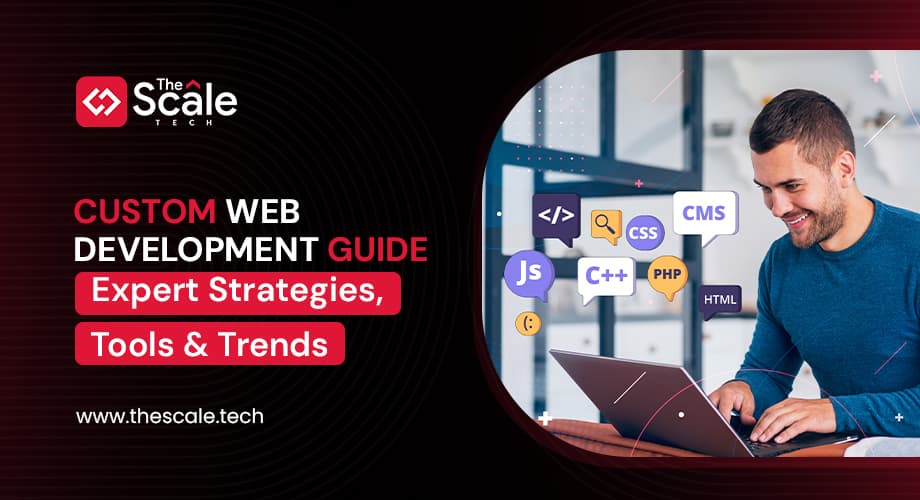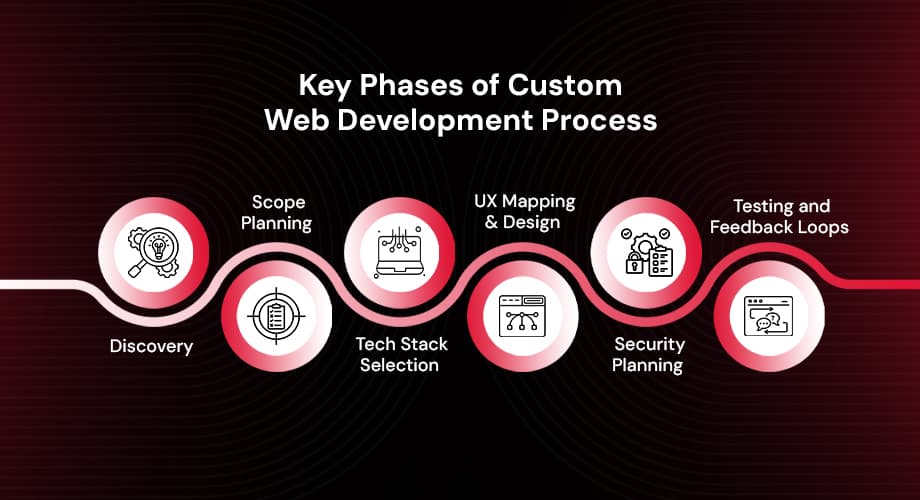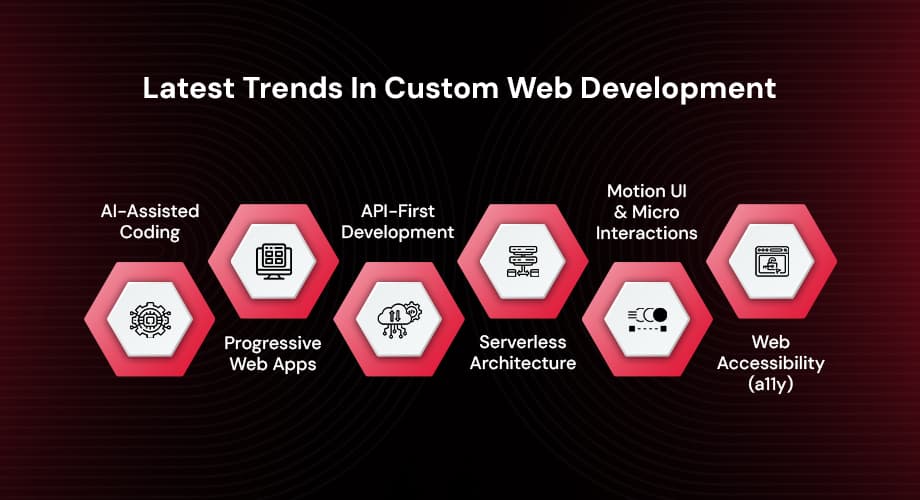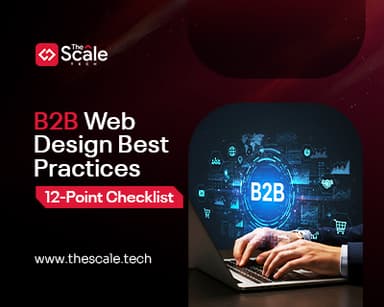
Ever feel like your website is speaking a language your users don’t understand? Most websites are just... fine. They load, they scroll, they display content. But fine doesn't cut it anymore. If you’re serious about growth, performance, and brand credibility, “fine” isn’t the goal. This is where a custom web development guide actually matters.
Because what you really need isn’t just a website. You need a system. A digital experience. A platform built from the ground up that works as hard as your team does. Not just another theme-powered site that looks like a dozen others. This guide? It’s the deep dive into custom website development you didn’t know you needed. We’re going to break down the why, the how, the tech, the cost, the benefits, and yes, every strategy that top developers and UX teams use in 2025. Ready to see what custom really looks like?
TL;DR – What’s Inside This Custom Web Development Guide
- What custom web development actually means
- When to choose it over templates
- Key benefits for growing businesses
- Proven custom web development strategy steps
- Best custom web development tools used by pros
- Real custom web development trends worth watching
- Common web design mistakes to avoid
- The real web development cost breakdown
- How web development AI tools are changing workflows
- The complete web development process simplified
- What a custom web development company really brings to the table
What Is Custom Web Development?
So, what’s ‘custom’ web development here? What’s the context of customization? Let’s keep it simple! Custom web development means building a website, or you can say a web app, tailored to your exact goals, no shortcuts, no third-party templates, no common frameworks. Everything from the layout to the logic is designed with a purpose. To serve your users, your brand identity, and your future growth.
It’s the opposite of “drag, drop, and publish.” Instead of relying on prebuilt components, developers create each module, flow, and interface with full control. You choose the tech stack, the UX, the backend logic, and how everything integrates. At its core, custom website development gives you:
- Clean, scalable code
- Faster performance and loading times
- Built-in SEO structure
- Tight security based on your infrastructure
- Complete freedom over functionality
In fact, security is also a major part of the custom web development benefits. According to IBM’s 2023 Data Breach Report, the typical financial impact of a data breach has climbed to $4.45 million, with small and mid-sized businesses facing the highest risk. But how? By opting for custom website development, organizations can build security directly into the foundation of their digital platforms.
Why Should You Choose Custom Development Over Templates?
This question pops up a lot. And it’s fair. Templates are quicker, cheaper, and often “good enough.” But they also come with ceilings. Performance ceilings. Flexibility ceilings. UX limitations. So, if you’re building a side blog or testing an idea, go for a template. But if you’re building something that will carry your business, handle transactions, collect data, or scale with user demand, you should be working with the best web development technologies. You’ll want the freedom that only custom web development can offer.
Let’s dig deeper. The custom web development benefits stack up like this:
- Your branding stands out because the site is built just for you
- The user experience fits real customer behavior not generic flows
- Performance stays fast thanks to clean efficient code made for your content
- You only integrate what you actually need APIs CRMs whatever fits
- Security isn’t one size fits all you decide what protection looks like
- As your business grows your site can grow right along with it
Templates might get you online, but custom web design and development ensure you stay ahead. Now, here’s a quick go-through!
| Benefits | What It Means |
|---|---|
| Unique Branding | Your site has a one-of-a-kind look and feel. |
| Tailored UX | User journeys are mapped to real customer behavior. |
| Optimized Performance | Clean, lightweight code ensures faster loads. |
| Built-in Integrations | Connect only the APIs, CRMs, and tools your business needs. |
| Security Customization | Add encryption, protocols, and protections specific to you. |
| Long-Term Scalability | Easily upgrade features as your company evolves. |
Key Aspects Of A Custom Web Development Strategy
If you’re building without a strategy, you’re guessing. A strong custom web development strategy is what turns an idea into a successful product. It outlines not just what to build, but why, how, for whom, and when. Without this plan, even the best code falls flat. So, you must be prioritizing custom web development best practices.

Let’s look at the key phases of any custom web development process:
Discovery
Define user personas, business goals, and market needs. This is where you figure out what your users want, not just what looks trendy.
Scope Planning
Clarify what the website must do. Which features are MVP? Which can wait? How do users flow from page to page?
Tech Stack Selection
Choose the right tools: front-end frameworks, back-end logic, databases, and servers. Your choice should match business needs, not developer bias.
UX Mapping & Design
Sketch user flows, wireframes, and design UI elements. Great UX starts with intention, not aesthetics.
Security Planning
Define user permissions, encryption protocols, and authentication systems. Build trust before it’s ever broken.
Testing and Feedback Loops
Testing isn’t a final step; it’s a recurring one. QA, usability testing, and iterative feedback cycles matter.
Every effective custom web development company uses this type of roadmap. It’s not about making things fancy, it’s about making them functional, efficient, and ready to scale.
What Tools Do Developers Use for Custom Web Development?
Let’s talk about the best developer tools. When it comes to custom web development tools, the stack will change based on the team, the goals, and the complexity. But there are some tried-and-tested favorites that nearly every serious developer relies on.
Here’s a breakdown of top web development technologies and tools:
- Front-End Tools
React, Vue.js, Svelte, Tailwind CSS, Bootstrap
- Back-End Tools
Node.js, Laravel, Django, Ruby on Rails, Express
- Version Control & DevOps
Git, GitHub, Bitbucket, Docker, Jenkins
- APIs & Testing
Postman, Swagger, Mocha, Cypress, Selenium
- CMS Options for Hybrid Custom Builds
Headless CMS (Strapi, Sanity, Contentful)
- Deployment & Hosting
AWS, Vercel, Netlify, Firebase
Choosing the right one comes down to what your project actually needs, not just what’s popular on dev forums. If you’re working with a web development company, they’ll likely suggest a stack based on team strengths and use case. But it’s always smart to understand what powers your own platform.
| Category | Tools / Technologies |
|---|---|
| Front-End | React, Vue.js, Svelte, Tailwind CSS, Bootstrap |
| Back-End | Node.js, Laravel, Django, Ruby on Rails, Express |
| Version Control & DevOps | Git, GitHub, Bitbucket, Docker, Jenkins |
| APIs & Testing | Postman, Swagger, Mocha, Cypress, Selenium |
| Headless CMS | Strapi, Sanity, Contentful |
| Deployment & Hosting | AWS, Vercel, Netlify, Firebase |
What Are The Latest Trends In Custom Web Development?

Let’s look ahead.
The world of custom web development trends is moving fast. New frameworks, new devices, new user behaviors, it’s a lot to keep up with. But if you want your site to stay relevant (and functional), you need to know what’s coming. For instance, consider speed. According to Google, approximately 53% of mobile users will leave a site if it takes more than three seconds to load.
Here are some trends that are actually worth your attention:
- AI-Assisted Coding: Tools like GitHub Copilot are helping devs write faster, cleaner code. Combined with prompt-based UIs, they speed up prototyping.
- Progressive Web Apps: Websites that work offline, send push notifications, and feel like native apps. Users love them. So does Google.
- API-First Development: Everything is becoming modular. This allows easier scaling and faster integration across devices.
- Serverless Architecture: More teams are ditching traditional server setups for AWS Lambda or Google Cloud Functions. Less overhead, more speed.
- Motion UI & Micro Interactions: Subtle animations now play a huge role in UX, helping users engage and navigate intuitively.
- Web Accessibility (a11y): Custom sites are no longer ignoring accessibility. From ARIA roles to contrast testing, a usable site is now a must.
Many of these trends are powered by emerging web development AI tools, helping automate repetitive tasks and boost efficiency without compromising quality.
Common Mistakes In Custom Web Design
Even with the best strategy, mistakes still happen. And when they do? They’re often expensive, costing you time, conversions, and reputation. Custom doesn’t always mean better, especially when you fall into common traps that look harmless but hurt in the long run.
Some of the biggest web design mistakes developers and brands make include:
- Designing for trends, not usability
- Ignoring mobile responsiveness
- Overcomplicating navigation
- Poor performance optimization (slow images, render-blocking JS)
- Weak internal linking and crawlability
- Inconsistent branding or unclear CTAs
- Forgetting accessibility compliance (color contrast, keyboard nav, etc.)
- Building a stunning UI but ignoring UX flow
Even well-known brands slip on these basics. But the fix often lies in a stronger custom web development strategy that prioritizes the user, not aesthetics alone.
| Design Mistake | Why It Hurts |
|---|---|
| Trendy > Usable | Confuses real users |
| No Mobile Optimization | Breaks on small screens |
| Complex Navigation | Users get lost |
| Slow Performance | Users bounce fast |
| Weak Linking Structure | Hurts SEO |
| Inconsistent Branding | Lowers trust |
| No Accessibility | Excludes users |
| Pretty UI, Bad UX | No conversions |
How Custom Web Development Impacts Digital Accessibility Compliance
Here’s something most businesses overlook until it’s too late: legal compliance with digital accessibility standards. Accessibility is a legal and moral requirement. And this is where custom web development gives you a massive edge over plug-and-play templates.
When you’re building from scratch, you have complete control over how accessible your site is for users with visual, auditory, cognitive, or motor impairments. This includes screen reader compatibility, keyboard navigation, skip links, contrast ratios, focus indicators, ARIA labels, and semantic HTML structures. Templates rarely offer this level of control. And retrofitting accessibility into a prebuilt layout? That can get messy fast.
With custom builds, developers can align your site with major standards like:
- WCAG 2.1 and 2.2 (Web Content Accessibility Guidelines)
- ADA (Americans with Disabilities Act)
- Section 508 Compliance (for U.S. federal sites and contractors)
Custom code allows you to bake accessibility into your web development process, not patch it later. That means fewer legal risks, better SEO (yes, Google loves accessible code), and a wider audience reach. Plus, accessibility improves UX for all users. Think about captions on videos, text resizing, or simplified layouts; they help everyone, not just users with disabilities.
If your site serves a large or diverse audience, then designing with accessibility in mind from the start is one of the smartest custom web development strategies you can invest in. And it's something templates will never do well, because they weren’t built for your users.
How Much Does Custom Web Development Cost?
Web development cost varies wildly. There’s no single answer because no two custom builds are the same. But understanding what affects the cost helps you budget smartly. Here’s what influences the price tag:
- Complexity of features and integrations
- Number of pages and layouts
- Custom animations or 3D assets
- CMS (custom-built vs. headless vs. hybrid)
- Ecommerce or user login systems
- Security requirements (HIPAA, GDPR, etc.)
- Maintenance plans or support contracts
Hiring a custom web development company or web development agency also affects pricing based on their expertise, team size, and support capabilities. On average? Custom websites for mid-sized businesses range between $15,000 to $100,000+. Web apps go even higher. But remember, it’s not just cost. It’s return on investment.
How Are AI Tools Changing Custom Web Development?
This one’s exciting. AI has officially entered the developer’s toolbox, and it’s doing more than just auto-filling code. Modern web development AI tools are helping devs think, build, and debug faster. Here’s how:
- Code Autocompletion: GitHub Copilot predicts syntax and logic
- AI-Generated Layouts: Tools like Uizard and Relume turn prompts into wireframes
- Automated Accessibility Checks: axe DevTools and WAVE help maintain a11y
- Smart Bug Fixing: AI models identify likely errors and suggest fixes
- Natural Language Code Prompts: AI turns “Build me a contact form” into HTML
These tools don’t replace developers. They just make the repetitive parts faster, freeing up time to focus on architecture, UX, and scalability. If you’re a startup or small team, leveraging AI in custom web development can seriously level the playing field.
Difference Between A Website And A Web Application
A custom web application development project is very different from a marketing site. Let’s break it down simply:
- Websites present information
- Web apps process information
A marketing site may include blogs, landing pages, contact forms, and product pages. It’s largely read-only. A custom web app handles user interaction, data storage, real-time updates, and logic-based responses. The development approach, custom web development best practices, tools, and performance requirements change drastically when you move from static content to interactive logic. Examples of custom web applications:
- Dashboards
- Booking systems
- Inventory management tools
- SaaS platforms
- Online marketplaces
- Learning management systems
| Websites | Web Applications |
|---|---|
| Show information | Process information |
| Read-only content | Interactive and dynamic |
| Blogs, landing pages, contact forms | Dashboards, bookings, portals |
| Simple structure | Complex logic and workflows |
| Minimal user input | HData-driven with real-time updates |
| Built for visibility | Built for functionality and use cases |
How To Choose The Right Web Development Agency
If you’re not building it yourself, you need help. But finding the right web development agency is trickier than just comparing portfolios.
Look for:
- Strategy-first thinking
- Transparent process documentation
- Experience in your industry or niche
- Emphasis on security, performance, and UX
- Post-launch support and scalability planning
- Clear communication and timelines
Good agencies will treat your website like a product, not just a project. And in a space where tech evolves fast, that mindset makes all the difference.
Why Custom Web Development Is Worth It
You’ve made it this far, so let’s wrap it all up. This custom web development guide gave you the foundation for understanding the why, the how, and the what's next of building something from scratch. Whether you’re planning a product launch, rebuilding a tired website, or starting a new digital platform, going custom means:
- Freedom over your features
- Performance that matches your traffic goals
- A UX designed for your users, not someone else’s
- Security that fits your industry standards
- The ability to grow, pivot, and scale without limits
From custom web development tools and strategy to trends, design, and mistakes to avoid, you're now equipped to start the process with clarity. And if you're still wondering whether it’s worth the investment? Ask yourself this: When was the last time you were impressed by a template? Ready to move from limitations to possibilities? Let’s create something that actually fits. Reach out. Start the blueprint!







